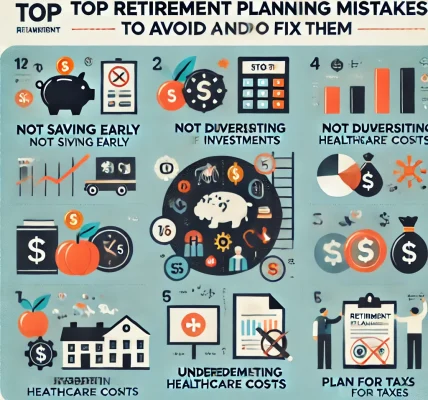Retirement planning is a crucial step in ensuring financial security and stability during your golden years. One of the most important decisions to make is choosing between an employer-sponsored retirement plan and an individual retirement plan. Each has its own benefits and drawbacks, and the right choice depends on your financial goals, job stability, and investment preferences.
In this article, we’ll break down the key differences between these two types of retirement plans, their advantages and disadvantages, and how to determine which is best suited for you.
What Are Employer-Sponsored Retirement Plans?
Employer-sponsored retirement plans are savings programs offered by employers to help their employees save for retirement. These plans often come with added benefits like employer contributions, tax advantages, and automated savings.
Types of Employer-Sponsored Retirement Plans
- 401(k) Plans – One of the most common plans in the U.S., allowing employees to contribute pre-tax earnings, with possible employer matching contributions.
- 403(b) Plans – Similar to a 401(k) but designed for employees of non-profit organizations, schools, and certain government institutions.
- Pension Plans (Defined Benefit Plans) – Employer-funded plans that guarantee a fixed income post-retirement based on salary and years of service.
- SEP-IRA & SIMPLE IRA – Designed for small business owners and self-employed individuals, providing tax-deferred retirement savings options.
Pros of Employer-Sponsored Retirement Plans
✅ Employer Matching Contributions – Many employers offer matching contributions, which is essentially free money towards your retirement savings. ✅ Tax Benefits – Contributions are typically tax-deferred, reducing your taxable income. ✅ Automated Contributions – Deductions happen directly from your paycheck, ensuring consistent savings. ✅ Higher Contribution Limits – Employer-sponsored plans generally allow for higher contribution limits than individual retirement accounts (IRAs). ✅ Potential for Vesting & Profit-Sharing – Some companies offer additional benefits such as profit-sharing or vested employer contributions.
Cons of Employer-Sponsored Retirement Plans
❌ Limited Investment Options – Employees are typically restricted to the investment choices offered within the plan. ❌ Employer Dependency – If you leave the company, you may need to roll over your savings or face penalties. ❌ Fees and Management Costs – Some plans come with high administrative fees, which can eat into your savings. ❌ Required Minimum Distributions (RMDs) – At a certain age (typically 73), required minimum distributions apply, affecting tax strategy.
What Are Individual Retirement Plans?
Individual retirement plans are savings accounts set up and managed by individuals, offering flexibility and control over investment choices. These accounts are particularly useful for self-employed individuals, freelancers, or those without access to employer-sponsored plans.
Types of Individual Retirement Plans
- Traditional IRA – Contributions are tax-deductible, and withdrawals are taxed at retirement.
- Roth IRA – Contributions are made with after-tax income, but withdrawals (including earnings) are tax-free in retirement.
- Solo 401(k) – Designed for self-employed individuals, offering high contribution limits and tax benefits.
- Brokerage Accounts – Not a retirement plan per se, but can be used to invest and build long-term wealth.
Pros of Individual Retirement Plans
✅ Full Control Over Investments – You choose where to invest (stocks, bonds, ETFs, mutual funds, etc.). ✅ Tax Flexibility – With options like Roth IRAs, you can decide when to pay taxes on your savings. ✅ Portability – Your account is not tied to any employer, making it easier to manage when changing jobs. ✅ Lower Fees – Many IRAs have lower administrative costs compared to employer-sponsored plans. ✅ No RMDs for Roth IRAs – Unlike 401(k) plans, Roth IRAs do not require minimum distributions.
Cons of Individual Retirement Plans
❌ Lower Contribution Limits – Compared to employer-sponsored plans, IRAs have lower annual contribution caps. ❌ No Employer Match – Unlike 401(k)s, individual plans do not benefit from employer contributions. ❌ Income Limits (for Roth IRAs) – High earners may have restrictions on Roth IRA contributions. ❌ More Responsibility – The individual must actively manage and make investment decisions.
Employer-Sponsored vs. Individual Retirement Plans: Key Differences
| Feature | Employer-Sponsored Plans | Individual Retirement Plans |
|---|---|---|
| Contribution Limits | Higher limits | Lower limits |
| Employer Matching | Available (in most cases) | Not available |
| Investment Choices | Limited selection | Full control over investments |
| Tax Benefits | Pre-tax contributions | Tax-deferred or tax-free options |
| Rollover Requirements | Must roll over when changing jobs | Not required, stays with you |
| Administrative Fees | Potentially high | Generally lower |
| Access to Funds | Restricted before retirement | More flexible (subject to penalties) |
Which Retirement Plan Is Right for You?
Choosing between an employer-sponsored retirement plan and an individual retirement plan depends on various factors:
✔ If your employer offers a 401(k) with matching contributions, take full advantage of it first. ✔ If you’re self-employed or a freelancer, a Solo 401(k) or SEP-IRA can offer great tax advantages. ✔ If you prefer greater investment flexibility, an IRA may be a better choice. ✔ If you expect to be in a lower tax bracket at retirement, a Traditional IRA or 401(k) can be beneficial. ✔ If you want tax-free withdrawals in retirement, a Roth IRA is a solid option.
Final Thoughts
Both employer-sponsored and individual retirement plans have unique benefits and drawbacks. The best strategy is often a combination of both: maximize employer contributions in a 401(k) while also investing in an IRA for additional tax diversification and investment control.
By understanding the differences and aligning them with your financial goals, you can create a well-rounded retirement plan that ensures financial security for the future.




